ORLANDO, Fla — Did you start "exercising" your New Year's resolution yet? Already feeling achy?
It's not uncommon to have a lingering injury or nagging pain. A national survey by Orlando Health found nearly one in five Americans (18%) often experience pain while working out, and the same number of people work through the pain rather than resting to heal.
Sports medicine physicians and orthopedic surgeons at the Orlando Health Jewett Orthopedic Institute say identifying the source of pain is the first step toward feeling better, and new advancements offer a range of options before surgery is part of the discussion. However, delaying treatment often leads to further damage and a higher likelihood that surgery will be needed to repair it.
“There's the saying, 'No pain, no gain,' but there's different types of pain that you feel during workouts, and sharp, stabbing pain that's very uncomfortable is not typically normal," Dr. George Eldayrie, a sports medicine physician at the institute, said. "The pain may be coming from an underlying problem, and if you continue to push through it, you can make that problem worse."
Non-surgical options may include physical therapy to stretch and strengthen specific muscles and tendons. It may also involve injections that reduce inflammation and promote healing such as corticosteroids and platelet-rich plasma, which are delivered precisely to the right area using ultrasound technology.
"Platelet-rich plasma has also been shown to be very effective for chronic tendinopathies — things like tennis elbow or golfer's elbow," Eldayrie added. "But it typically works better the earlier it is administered, before the injury progresses."
Surgery is often best for injuries requiring repair or reconstruction that will not heal on their own. However, advancements in robotic and laparoscopic procedures have made many surgeries less invasive and recovery shorter and easier.

